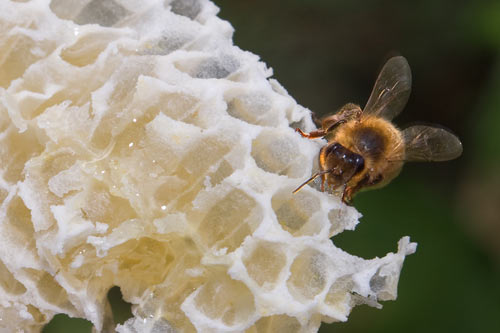
The ‘Why’ of Beehive Design
The behavior of honeybees is fascinating and complex, and honeybees are vital to the pollination of very many crops. This makes the fact that they are under threat of extinction worldwide from colony collapse disorder (CCD) all the more serious. [ See this article Honey Bees: Nature’s Linchpin In Great Peril ]
I wanted to take some photographs of bees, so we went to see a demonstration of beekeeping. I saw the beekeeper lifting the frames from inside the hive and examining them, but I didn’t understand the ‘why’ of what I was looking at.
Then a couple of weeks later I saw a display at the apiary of the Leeds Beeskeepers Association and the reason for the design of modern beehives became clear.
Skeps
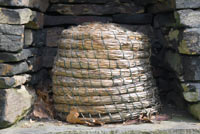
This is a traditional straw beehive, known as a skep. It is the kind of beehive that was used for centuries in England and which continued in use until well into the 1800s. You probably recognize the shape, which is found on the labels of jars of honey and used as the design for little pottery honey pots.
It is made of a rope of straw tied into a shape to mimic the shape of a natural hive that bees might look for in a hollow in a tree or between rocks.
The design varies a little, with some skeps having the entrance at the top while others have them at the bottom, but they all share one characteristic, which is that the beekeeper has to destroy the hive to get the honey out.
The Bee Space
Then in the 1850s the Reverend L. L. Langstroth noticed that bees will not bring the surfaces of two combs closer together than a ‘bee space’ – about the width of a finger – and that piece of knowledge is what determines the interior arrangement of modern hives.
Modern Hives
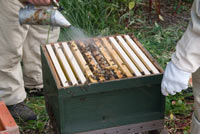
Modern hives use sheets of beeswax stretched on wooden frames. The frames are hung inside the outer case of the hive with a bee space between them. A bee space is also left around the edges of the frames so that the bees can move freely inside the hive.
To encourage the bees to start building combs as quickly as possible, the sheets are impressed with a honeycomb shape. The bees could bridge the space between the frames if they wanted to, but they generally don’t want to because they want access to the cells, so the design suits the bees and the beekeeper.
In The Frame
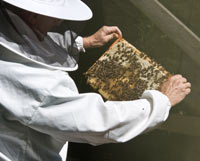
Beekeepers use a hive tool – a flat bar of metal with a hook at one end – to lever out the frames from the hive so they can inspect them. Even with the bee space design, the bees may still extend the combs beyond the end of the frame, and the beekeeper then has to scrape that off otherwise he or she won’t be able to fit the frame back in the hive.
The honeybee in the photograph at the top of this article is sitting on a piece of comb that the beekeeper had scraped off a frame.
Bee Chains
One other fact of honeybee behavior is that honeybees like the dark and when a beekeeper lifts out a frame to examine it, the bees tend to migrate to the darkest part on the frame – at the bottom. And they may hang on and form a bee chain like in this photograph.
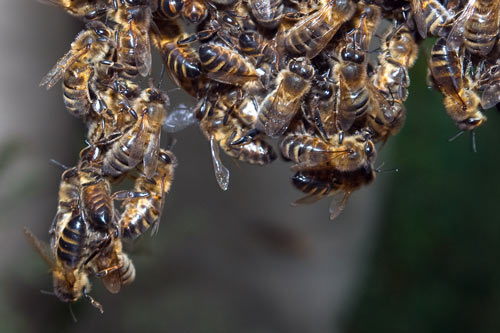
I actually missed the point when the chain was at its longest, which was about twice the length in this photograph.
Photographing Bees
I wanted to photograph honeybees for these articles and also for our ecards, but it is proving more difficult than I imagined.
The reason is that bees move constantly. They have four wings (with each pair on either side hooked together when the bee is at rest) and when they are out foraging for nectar and pollen, their wings are buzzing more or less constantly, and very fast.
And in the hive they are constantly fanning the honey to drive off moisture before they cap the cells with wax.